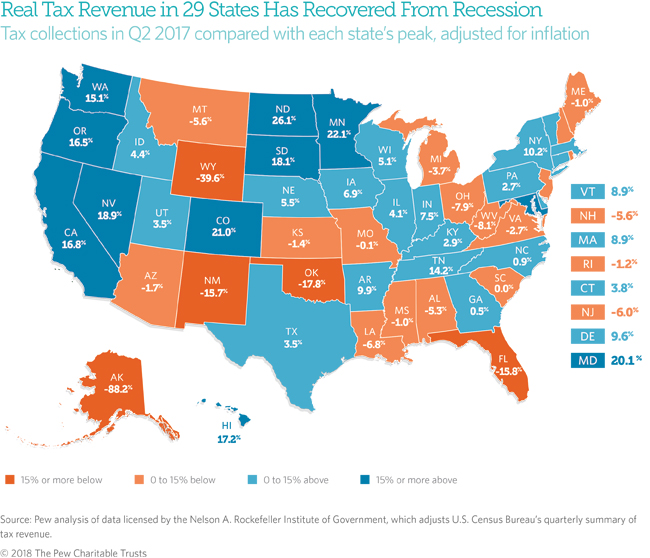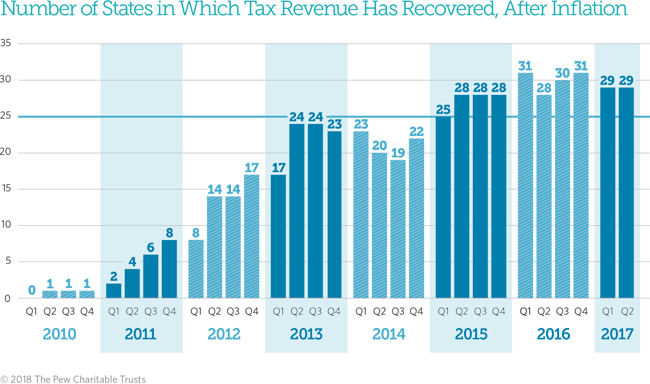Connecting state and local government leaders
Most states recorded more robust growth in overall tax collections at the start of fiscal 2018, according to preliminary data collected by the Nelson A. Rockefeller Institute of Government. But federal tax reform has brought plenty of uncertainty.
This article was originally published by The Pew Charitable Trusts as part of the States' Fiscal Health initiative and was written by Barb Rosewicz and Daniel Newman.
State tax collections grew unusually slowly over the past couple of years, creating budget challenges even for some states whose revenue has rebounded from the Great Recession. Tax receipts in 29 states had recovered from losses in the downturn by the second quarter of last year, the close of fiscal 2017 for most states, after accounting for inflation.
Even as the nation’s economy expanded in 2017 for the eighth year in a row, state tax revenue had its weakest two-year stretch of growth—outside of a recession—in at least 30 years.
States collectively took in 6.3 percent more in the second quarter of 2017 than they did before total receipts plunged in late 2008 in the middle of the downturn, after accounting for inflation and averaging across four quarters to smooth seasonal fluctuations. States had more tax dollars than at the same point in 2016, when 50-state revenue was 5.8 percent above its 2008 peak after barely rising from 5.7 percent in mid-2015. But taken together, growth over the two fiscal years was exceptionally weak.
Slow growth can make it hard for states to balance their budgets. Even if revenue increases, states may face higher expenditures because of population growth, changes in Medicaid costs and enrollment, and deferred or new needs for schools, safety-net programs, corrections, employee salaries and pensions, and road maintenance and construction.
The latest results mean that the 50 states combined had the equivalent of 6.3 cents more in purchasing power in mid-2017 for every $1 they collected at their peak in 2008.
With little short-term growth in purchasing power, more states than at any time since the end of the recession reported midyear budget gaps in fiscal 2017. Amid weak revenue trends, an unusually large number—11 states—missed deadlines for passing balanced budgets for fiscal 2018, and those budgets provided the lowest increase in state general fund spending—2.3 percent—since 2010, according to the National Association of State Budget Officers (NASBO).
Most states recorded more robust growth in overall tax collections at the start of fiscal 2018, according to preliminary data collected by the Nelson A. Rockefeller Institute of Government. But uncertainty loomed because the federal tax cut signed by President Donald Trump in December 2017 incorporates a range of changes to federal tax exemptions, deductions, and credits that could carry over and trigger changes in state tax collections. In addition, there are signs that taxpayers began shifting income to minimize their federal and state tax bills even before Congress passed the measure.
Since the 2007-09 recession, total state tax revenue has been slower to rebound than it did after any of the three previous downturns. But trends have varied widely by state. In 10 of the 29 states in which collections had recovered from their recession losses by mid-2017, tax revenue—and thus purchasing power—was more than 15 percent higher than at its peak before or during the recession. Conversely, collections were down 15 percent or more in five of the 21 states in which tax revenue was still below peak.

State Highlights
A comparison of each state’s tax receipts in the second quarter of 2017 with its peak quarter of revenue before the end of the recession, averaged across four quarters and adjusted for inflation, shows:
- Ten states posted tax revenue rebounds of 15 percent or more: North Dakota (26.1 percent), Minnesota (22.1 percent), Colorado (21.0 percent), Maryland (20.1), Nevada (18.9), South Dakota (18.1 percent), Hawaii (17.2 percent), California (16.8 percent), Oregon (16.5 percent), and Washington (15.1 percent).
- North Dakota remained the leader among all states in tax revenue growth since the recession, although its collections have dropped dramatically since the 2014 plunge in oil prices. At the end of that year, receipts hit a high of 124.5 percent above their peak during the recession, compared with 26.1 percent above in the second quarter of 2017.
- Alaska (-88.2 percent) was furthest below its peak. This means the state collected only about 12 percent as much in inflation-adjusted tax dollars as it did at its short-lived peak in 2008, when a new state oil tax coincided with record-high crude prices. Without personal income or general sales taxes, Alaska is highly dependent on oil-related severance tax revenue, which began falling even before worldwide crude prices declined in 2014 as its oil production waned.
- Four additional states were down more than 15 percent from their previous peaks: Wyoming (-39.6 percent), Oklahoma (-17.8 percent), Florida (-15.8 percent), and New Mexico (-15.7 percent).
- Wyoming (-39.6 percent) hit a new low in tax collections since the recession. Tax revenue had fallen for nine straight quarters amid weakness in the coal, oil, and natural gas industries.
- But as energy prices picked up somewhat, tax revenue declines tapered off in several other states that depend on fossil fuel production: Alaska, Louisiana, Montana, North Dakota, Oklahoma, Texas, and West Virginia. (Louisiana also raised sales, cigarette, and alcohol taxes in 2016.)
- Illinois’ tax revenue dropped for 11 straight quarters—the lengthiest slide in any state—after a temporary personal income tax increase expired at the end of 2014. However, a new permanent hike took effect in July 2017 and will be reflected in future results.
- Oregon (16.5 percent) exceeded a constitutional cap on tax revenue growth in fiscal 2017, triggering a refund to taxpayers.
Latest Trends
Fiscal 2017 ended on an up note after nearly flat growth the previous year, with total tax revenue rising slightly in the final quarter. However, inflation-adjusted receipts fell in 16 states, including nine of the 29 in which receipts had recovered from their recession-era losses.
State tax revenue—like the U.S. economy—has grown slowly and unevenly since the recession. In the past couple of years, collections have been stymied in certain states by sagging energy and crop prices and nationwide by weak wage growth. Stock market drops in late 2015 and early 2016 reduced income tax revenue from capital gains. More broadly, consumer spending has been migrating toward services and online purchases that are less likely to be taxed.
In the year before passage of the federal tax cut, taxpayers—especially high-income earners—also had incentive to delay income or accelerate deductions to try to lower their tax liabilities, which could have held down tax payments in fiscal 2017. Similar income shifting by taxpayers resulted in lower state tax collections in fiscal 2014.
State policymakers also have contributed to revenue trends, enacting tax cuts in states such as North Dakota and Texas and hikes in states such as Louisiana and Washington. According to NASBO, states in fiscal 2014 and 2015 enacted more tax cuts than hikes overall, while doing the reverse in the next two years.
Trends Since the Recession
Nationally, tax revenue recovered from its losses in mid-2013, after accounting for inflation. But individual state results have differed dramatically depending on economic conditions, population changes, and tax policy choices since the recession.

In 2010, North Dakota was the first state to surpass its recession-era peak, followed by Vermont, then Arkansas and New York by mid-2011. Tax receipts were above peak in 14 states at the end of fiscal 2012; 24 states at the end of fiscal 2013; 20 states at the end of fiscal 2014; 28 states at the end of fiscal 2015; 28 states at the end of fiscal 2016; and 29 states at the end of fiscal 2017.
The number of states that have regained their tax revenue levels has risen and fallen, reflecting increased volatility in state tax collections as well as tax policy changes.
Among states in which tax revenue has recovered, some, such as Nevada and Washington, have raised taxes since the recession, contributing to gains. Among states in which receipts remain below their previous peaks, some, such as Florida and Ohio, chose to cut taxes since the recession.
State budgets do not adjust revenue for inflation, so tax revenue totals in states’ documents will appear higher than or closer to pre-recession totals. Without adjusting for inflation, 50-state tax revenue was 21 percent above peak and tax collections had recovered in 47 states—all except Alaska, Oklahoma, and Wyoming—as of the second quarter of 2017. Unadjusted figures do not take into account changes in the price of goods and services.
Adjusting for inflation is just one way to evaluate state tax revenue growth. Different insights would be gained by tracking revenue relative to population growth or state economic output.
Download the data to see individual state trends from the first quarter of 2006 to the second quarter of 2017. Visit The Pew Charitable Trusts’ interactive resource Fiscal 50: State Trends and Analysis to sort and analyze data for other indicators of state fiscal health.

NEXT STORY: When You Give Alaskans a Universal Basic Income, They Still Keep Working



